#choctaw
Text
Nex Benedict was an Indigenous, Two Spirit, Trans teenager who was murdered by three other students who attacked them in a school bathroom.
This is what we fight for, this is what we march for, this is what we have Pride for.
Because of the Anti-Trans hate and violence that is continuously being spewed.
Nex was a TEENAGER! WHO WAS BEATEN TO DEATH!
You say protect the children well NEX WAS A CHILD! WHERE WAS THEIR PROTECTION?

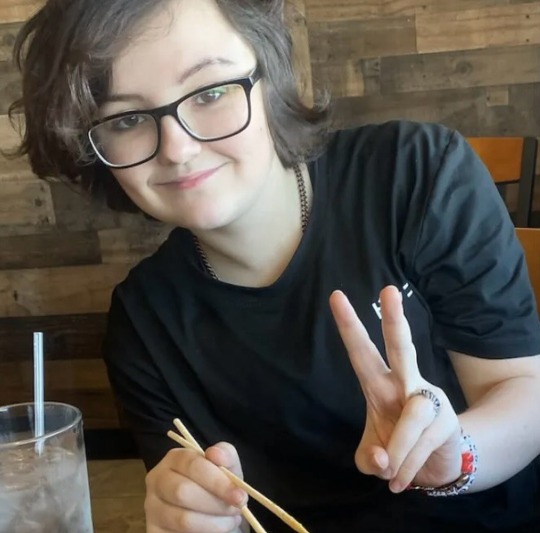
Nex I am so sorry, I'm so sorry this was done to you, you deserved to live a life full of love and joy. 💛💜🖤
Say his name, and never forget them.
Nex Benedict.
#nex benedict#transgender#trans#nonbinary#enby#lgbt#lgbtq#lgbtqa#punk#no one is free until we are all free#remember the martyrs and fight for the living#queer#pride#solarpunk#lgbtqia#trans rights#lgbtqia2s#two spirit#choctaw
6K notes
·
View notes
Text
Hozier's mention of the word "hushpukena" (a Choctaw word) in the song Butchered Tongue was, of course, not a random decision. In a song about the pain of being disconnected from your ancestral language and culture as a result of colonization and oppression from outside forces- which is something that both Irish and Native American people have experienced to varying degrees. Not only do Irish and Indigenous people have this shared history of colonization at the hands of the British, but Irish and Indigenous communities have a long history of support for one another.

The usage of "hushpukena" is even more specific and important because it calls back to the mutually positive relationship between Irish and Choctaw people specifically. During the Great Hunger in Ireland, the Choctaw Nation donated $170, which is more than $5,000 in today’s money, to aid the Irish. Out of all American aid given to Ireland during the famine, the donation from the Choctaw Nation was the largest donation given.

In 1990, leaders from the Choctaw Nation visited County Mayo in Ireland to participate in the first annual Famine Walk. In 1992, Irish people visited the Choctaw Nation and participated in a trek to commemorate the Trail of Tears. Also in 1992, a plaque commemorating the Choctaw's aid was installed in the house of the mayor of Dublin. In 1995, the Irish President Mary Robinson visited the tribal headquarters of the Choctaw Nation to thank the Choctaw people for their aid. In 2017, a sculpture named "Kindred Spirits" was built in Cork, Ireland to commemorate the Choctaw's aid and to continue friendship between the two communities. In 2018, the Taoiseach (prime minister) of Ireland visited Choctaw tribal headquarters and stated,"A few years ago, on a visit to Ireland, a representative of the Choctaw Nation called your support for us ‘a sacred memory’. It is that and more. It is a sacred bond, which has joined our peoples together for all time". In 2020, more than $1.8 million was raised by Irish people as aid for Native American people (specifically the Navajo and Hopi) during the pandemic, to help provide food, clean water, and health supplies.

#native american#indigenous#Choctaw#irish#ireland#great famine#the great famine#colonialism#colonization#Navajo#hopi
3K notes
·
View notes
Text

Choctaw and Ojibwe woman, Mikah Whitecloud, United States of America, by Evan Frost
#choctaw#ojibwe#united states of america#north america#america#folk clothing#traditional clothing#traditional fashion#cultural clothing
960 notes
·
View notes
Text
if anyone wants another layer to Butchered Tongue, consider Hozier's choice mention of Hushpuckena (Choctaw) and look up what the Choctaw nation did for the Irish during an Gorta Mór (The Great Hunger).
https://www.choctawnation.com/about/history/irish-connection/
2K notes
·
View notes
Text

Choctaw Spider-sona
#tesh draws#spider-sona#spidersona#across the spiderverse#smatsv#spidersona oc#marvel#spider-man#Choctaw#native artists
3K notes
·
View notes
Text
Echo was Marvel's redemption.
It was a beautiful show from beginning till the end.
But no one will talk about it.
Just like no one talked about Ms. Marvel or Hawkeye.
People will still say post Endgame Marvel is going to hell.
Cause we have another woman hero amongst us.
#shitpost#mylife#ms marvel#marvel cinematic universe#marvel series#marvel#echo#maya lopez#wilson fisk#taylor swift#choctaw#hawkeye#kamala khan#kate bishop
573 notes
·
View notes
Text
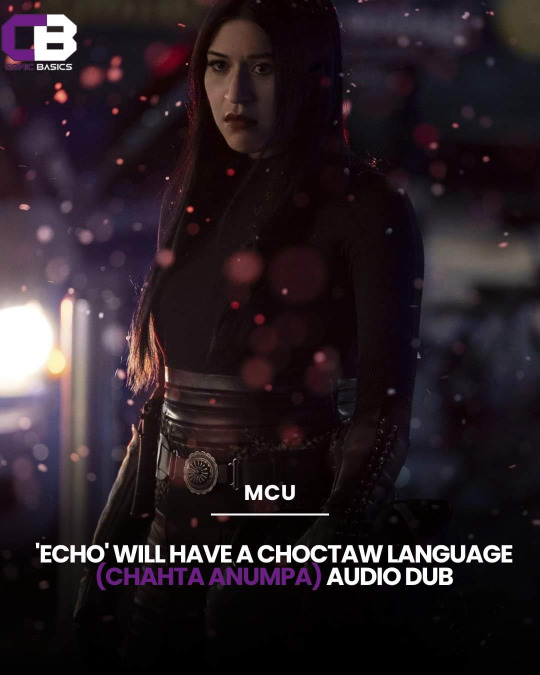
ECHO will have a Choctaw Language (Chahta anumpa) Audio dub!
#echo#mcu#marvel#maya lopez#alaqua cox#choctaw#chahta anumpa#indigenous representation#native representation#language
203 notes
·
View notes
Text
The leader of the Choctaw Nation is joining an outpouring of support for the family of a 16-year-old student whose death is being investigated in Oklahoma.
Nex Benedict passed away on February 8, following a physical altercation at a high school the day prior. Chief Gary Batton confirmed that the young student’s mother is enrolled with the Choctaw Nation.
“The loss of a child is always difficult for a community and a family to accept,” Batton said in a statement on Wednesday.
“Although Nex does not appear to be affiliated with our tribe, their mother, Sue Benedict, is a registered member,” Batton continued. “Nex’s death weighs heavily on the hearts of the Choctaw people. We pray Nex’s family and their loved ones will find comfort,” Batton concluded.
Nex’s death has directed widespread attention to Oklahoma, where Republican officials have increasingly adopted policies hindering the rights and freedoms of Two Spirit and LGBTQ+ people. Sue Benedict has embraced her child’s gender identity and has vowed to donate funds to other youth experiencing some of the same struggles.
Two Spirit and LGBTQ+ advocates incorrectly identified Nex as being a citizen of the Cherokee Nation, whose reservation borders that of the Choctaw Nation. Cherokee Chief Hoskin Jr. expressed support for the Benedict family on Tuesday.
“As Chief, the health and welfare of all children within the Cherokee Nation Reservation is of concern,” Hoskin said in a statement.
Nex attended Owasso High School in Owasso, located on the Cherokee Reservation. Local authorities are investigating the death and have said they will forward the results of the investigation to prosecutors in Tulsa County for potential action.
Hoskin has offered the support of the Cherokee Nation Marshal Service as the investigation continues. The Owasso Police Department indicated in a statement on Tuesday that interviews would be taking place “over the course of the next two weeks.”
Oklahoma Gov. Kevin Stitt (R), a Republican who happens to be a citizen of the Cherokee Nation, has not spoken publicly about the death. He has repeatedly derided efforts to address diversity, equity and inclusion as discriminatory.
But a senior official with President Joe Biden, a Democrat, has weighed in. White House Press Secretary Karine Jean-Pierre offered a message of support from the administration in a post on social media.
“Every young person deserves to feel safe and supported at school,” Jean-Pierre wrote on her official government account. “Our hearts are with Nex Benedict’s family, their friends, and their entire school community in the wake of this horrific tragedy.”
“For many LGBTQI+ students across the country, this may feel personal and deeply painful,” Jean-Pierre continued. “There is always someone you can talk to if you’re going through a hard time. Dial 988 and press 3 to reach a counselor dedicated to serving LGBTQI+ young people.
According to the 2023 LGBTQ+ Youth Report, a project of Human Rights Campaign and the University of Connecticut, more than half of transgender and gender-expansive youth feel unsafe at school. In particular, nearly a third said they feel unsafe in school restrooms.
“All students, including trans and gender-expansive students like Nex, have the right to feel safe and protected while attending school,” Tori Cooper, the campaign director of Community Engagement for the Transgender Justice Initiative at the Human Rights Campaign, said in a statement on Wednesday. “That Nex was only 16 years old compounds this tragic injustice and they should have lived to see a fulfilling and authentic life.”
The 2023 study was based on a survey of nearly 3,000 LGBTQ+ youth ages 13-18 nationwide, according to the organization. Some 0.6 percent of respondents identified themselves as American Indian or Alaska Native.
According to Owasso Public Schools, a “physical altercation” took place in a bathroom at the high school on February 7. The Owasso police responded to a local hospital on the same day of the incident.
Police then said they were informed that a “juvenile” was taken back to a hospital on February 8, the same day as Nex’s passing.
#op#links#trans#non-binary#choctaw#nex benedict#oklahoma#transphobia#hate crime#murder#child death#transphobic violence#uspol#news#bad news
122 notes
·
View notes
Text
hozier’s speech on the destruction of indigenous language from last night
234 notes
·
View notes
Text
❣️♀️Beloved Woman
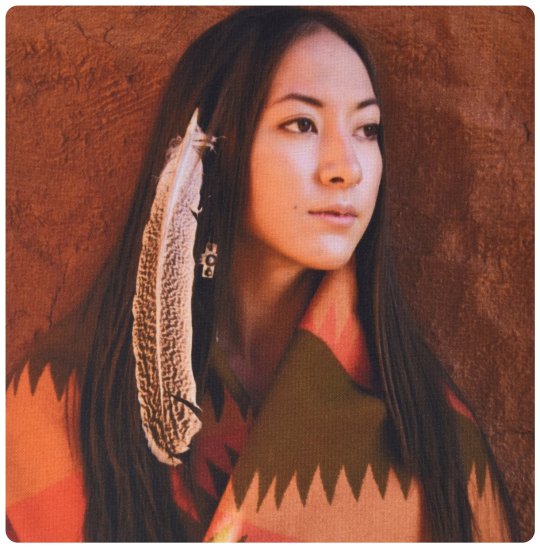
Cherokee Beloved Woman Nancy Ward
Nancy Ward, or Nan'yehi (nan yay hee), is the most famous Cherokee Beloved Woman. The role of Beloved Woman, Ghigau (Ghee gah oo), was the highest a Cherokee woman could aspire to. A Ghigau had a voice and vote in General Council, leadership of the Woman's Council, the honor of preparing and serving the ceremonial Black Drink, the duty of ambassador of peace-negotiator, and the right to save the life of a prisoner already condemned to execution.
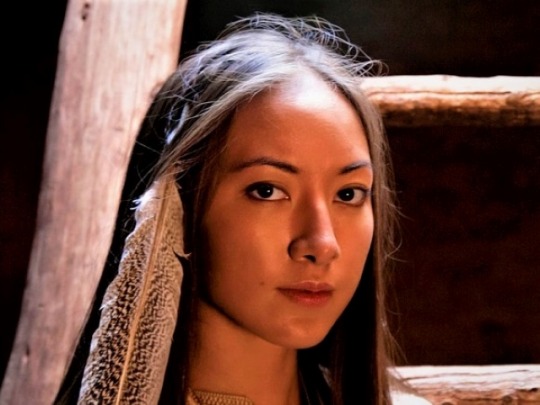
The Native American Cherokee
The word Cherokee is believed to have evolved from a Choctaw word meaning "Cave People." It was picked up and used by Europeans and eventually accepted and adopted by Cherokees. Traditionally, the people now known as Cherokee refer to themselves as aniyun-wiya, a name usually translated as "the Real People," sometimes "the Original People."
The Role of the Cherokee Woman
The Cherokee were matrilineal with a complex society structure. Clan kinship followed the mother's side of the family. The children grew up in the mother's house, and it was the duty of an uncle on the mother's side to teach the boys how to hunt, fish, and perform certain tribal duties. The women owned the houses and their furnishings. Marriages were carefully negotiated, but if a woman decided to divorce her spouse, she simply placed his belongings outside the house. Cherokee women also worked hard. They cared for the children, cooked, tended the house, tanned skins, wove baskets, and cultivated the fields. Men helped with some household chores like sewing, but they spent most of their time hunting.

Women in the Cherokee society were equal to men. This privilege led an Irishman named Adair who traded with the Cherokee from 1736-1743 to accuse the Cherokee of having a "petticoat government."
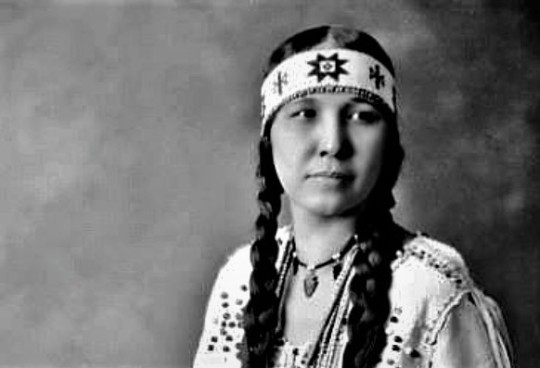
Princess Tsianina Red Feather
Tsianina Red Feather was not a "Princess." The Cherokee never had princesses. This is a concept based on European folktales and has no reality in Cherokee history and culture. Beloved women and high ranking women in a clan were treated with such reverence, that Europeans assumed they were some type of royalty.
Red Feather was born Florence Tsianina Evans on December 13,1882 in Eufallia (Oklahoma Territory) to Creek and Cherokee parents. All her 9 siblings were musical, but she was the one who stood out.
At age 14, she went to Denver to be trained to sing. There, she met the composer Charles Cadman and began touring with him at 16. She became a mezzo soprano virtuoso. While touring the United States, Canada, Paris and London, she wore native dress, braided her hair and wore a headband she beaded herself.

In 1918, she and Cadman debuted "Shanewis" (The Robin Woman) at the Metropolitan Opera; the cast received 22 curtain calls. Cadman based the opera on Native American stories told by Redfeather. Although this opera had many firsts, it became the first contemporary opera to be performed for a 2nd season at the Met.

The Robin Woman: Shanewis, 1918 - an opera in one act and two scenes by American composer Charles Cadman and Tsianina Redfeather Blackstone. Cadman called the work an "American opera."
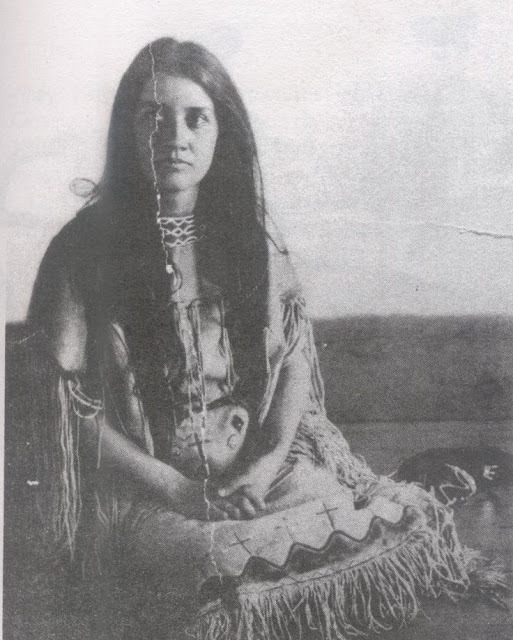
Photo is Miss Anna Trainor, who later became Mrs. Anna Bennett. She was only Cherokee on her mother's side, but because it was the woman's bloodlines that determined kinship, she was considered Cherokee.
The title Ghigau also translates to "War Woman," and Nan'yehi (Nancy Ward) earned the title by taking up her husband's gun when he was slain in a battle against the Creeks and leading her people to victory. Another War Woman, Cuhtahlatah, won honor during the American Revolutionary period by leading Cherokee warriors to victory after her husband fell. She later joined in a vigorous war dance carrying her tomahawk and gun.
It was important to the Cherokee that their losses be compensated with the same number of prisoners, scalps, or lives. Woman led in the execution of prisoners. It was their right and responsibility as mothers. Women had the right to claim prisoners as slaves, adopt them as kin, or condemn them to death "with the wave of a swan's wing."
In the Cherokee society your Clan was your family. Children belonged to the entire Clan, and when orphaned were simply taken into a different household. Marriage within the clan was strictly forbidden, or pain of death. Marriages were often short term, and there was no punishment for divorce or adultery. Cherokee women were free to marry traders, surveyors, and soldiers, as well as their own tribesmen.
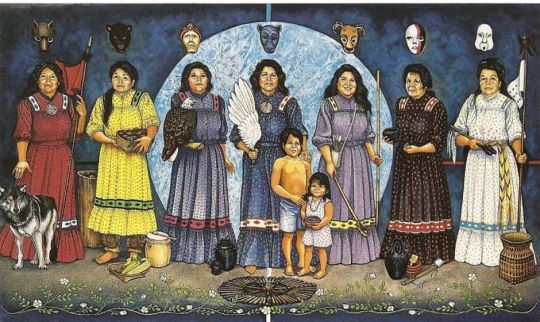
7 Cherokee Clans - L to R: 1.Wolf Clan 2.Long Hair Clan 3.Red Tail Hawk Clan 4.Blue Holly Clan 5.Deer Clan 6.Paint Clan 7.Wild Potato Clan
Cherokee girls learned by example how to be warriors and healers. They learned to weave baskets, tell stories, trade, and dance. They became mothers and wives, and learned their heritage. The Cherokee learned to adapt, and the women were the core of the Cherokee.
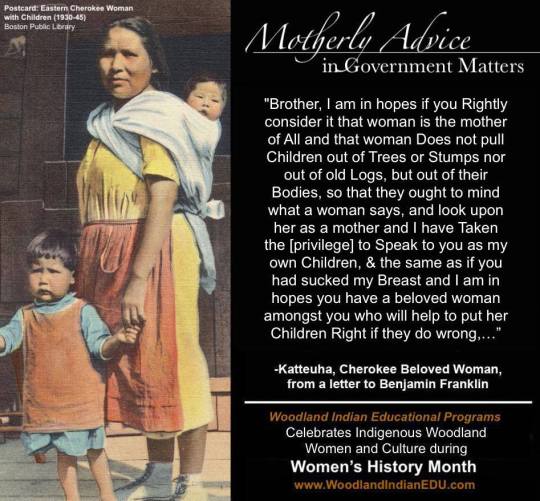
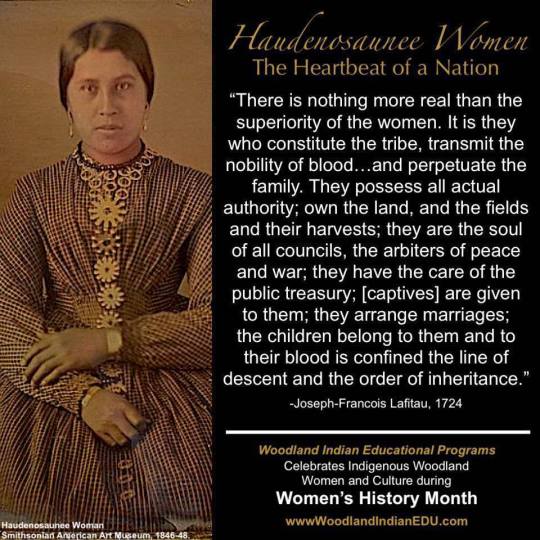
Other indigenous nations were were matrilineal. Women of the six nations Iroquois confederacy (Haudenosaunee) had a political voice on this land for at least 1,000 years.
The male chiefs who are the representatives of their clan in the confederacy of the Mohawk, Oneida, Onondaga, Cayuga, Seneca, and Tuscarora Nations are selected, held in office, and removed by women – the clan mothers. Founded on the shores of Onondaga Lake, this oldest continuing democracy in the world is based on a system of gender balance. The position of the chief is vested in the clan mother, who is the eyes and ears of the people, while the chief is her voice. Women were “the great power among the clan, as everywhere else,” Elizabeth Cady Stanton marveled. Lucretia Mott wrote about listening to “speeches of their chiefs, women as well as men” (clan mothers and chiefs) when she visited the Cattaraugus Seneca community during the summer of 1848 before Mott, with Stanton and Quaker friends, organized the Seneca Falls convention.
In other words, the Beloved and Haudenosaunee women influenced the Women's Suffrage Movement.
#original people#cherokee#native american#Beloved Woman#nancy ward#choctaw#Shanewis#clan#indigenous#women#katteuha#haudenosaunee woman#Iroquois confederacy#suffragette#women's suffrage#Elizabeth Cady Stanton#Lucretia Mott#Seneca Falls#clans#society#culture
227 notes
·
View notes
Text
The Choctaw Nation put together an entire page about their collaboration with Marvel on Echo.
Go learn more about the Choctaw people!
136 notes
·
View notes
Text
It has been almost two months since Nex Benedict's death and I am still devastated as I'm sure all of you are. I was doing some research. He had four sisters and two brothers. He had a cat named Zeus. His family, friends, and teachers all loved him. He loved reading, drawing, and playing Ark and Minecraft. How could something like this happen to an innocent kid who deserved so much better? He did nothing. And more importantly, this could have been prevented. Our world is messed up. Rest in power Nex, I'm sorry, you didn't deserve this <3
55 notes
·
View notes
Text
It is sick to see multiple trans people use the murder of Nex Benedict to bad mouth other trans people they don't see as oppression enough.
Even worse, many of them will turn around and say that race could not possibly have been a factor in the hate crime because Nex "Looked White."
These, mostly White, trans people will derail the Nex's life and murder to hurt other trans people and then, "Well, actually-" Native people who are in fact adding to the conversation.
This is fucking disgusting behavior, and while it would have been unacceptable regardless, it is worst still as we are dealing with a hate crime and murder of a child.
Non-binary people deserve better, Native people deserve better, Nex deserves better.
Do Better.
#nex benedict#exorsexism#racism#non binary#queer#two spirit#transgender#native american#indigenous#choctaw#people of color#white people#hate crime
92 notes
·
View notes
Text
My post about Nex Benedict was posted before there was any confirmation about them being Indigenous and Two-Spirit.
I have edited the post but it's not my fault tumblr doesn't update the reblogs with the original post.
If you go to the pinned post on my page you'll see what it actually says.
Rest in Peace Nex.
#nex benedict#lgbt#lgbtq#lgbtqia#lgbtqia2s#queer#two spirit#indigenous#choctaw#trans#transgender#trans rights#punk#transgender rights#enby#nonbinary
49 notes
·
View notes
Text
If you lived in the 1820s and 1830s, would you protest indigenous displacement? Would you countenance the destruction of entire family lines? Would you justify children dying as they walked hundreds of miles to Oklahoma, a territory the Choctaw renamed — Oklahoma is Choctaw for “land of the courageous” — in an attempt to maintain their dignity? Would you call them “barbarians” to ease your guilt? Would you buy into the myth of the “Vanishing Indian”, and pretend their extinction was preordained? Would you lie and claim the land was empty when the colonizers arrived?
* * *
You might know the answers to those questions based on how you respond to the ethnic cleansing of Palestinians. After obliterating northern Gaza, Israel forced surviving residents to walk south in scenes reminiscent of the Trail of Tears:
“We walked with thousands of other civilians. I even saw a hospital bed being pushed along the way,” wrote Palestinian journalist Hind Khoudary. “Children, people in wheelchairs, the elderly, babies — everyone was carrying their backpacks, pillows, and mats… Together, we walked. I studied the looks on people’s faces. Terrified, they were holding white flags…People crying, angry, sad, eyes filled with fear. My emotions were blocked. All I could think was that I do not want to leave, that it was wrong to leave, that I must not leave.”
As of January 2024, the Palestinian civilian death toll is now over 23,000, including over 10,000 children.
Israel promised Palestinians that southern Gaza would be safe, then bombed them as they arrived. Palestinians are now being told to go to Egypt, unless they are first deported to the Congo, where they would work in brutal conditions in mines owed by Israeli plutocrats like Dan Gertler. They are told Gaza will be taken over by Israel and turned into settlements under which their murdered countrymen will lie.
Those are Israel’s plans. They are of a nature so horrific they sound like something out of another century — the 1830s, perhaps.
But “settler-colonialism” is just a trendy new phrase, I’ve been told.
I wonder if the objection to accurate Black and Native American history — what political operatives label “critical race theory” as they censor this history in schools — has as much to do with curtailing understanding of current events as it does with past travesties. Political operatives do not want students to know about any indigenous struggles, foreign or domestic, particularly in countries like Israel closely tied to the US.
Parallels between Israel’s treatment of Palestinians and early America’s treatment of indigenous peoples are stark. Once you know the twin histories, you cannot unsee it.
Trails of Tears
From Oklahoma to Palestine
Sarah Kendzior
Jan 11, 2024
#indigineous people#colonization#settler colonialism#palestine#free palestine#isreal#united states#choctaw
93 notes
·
View notes